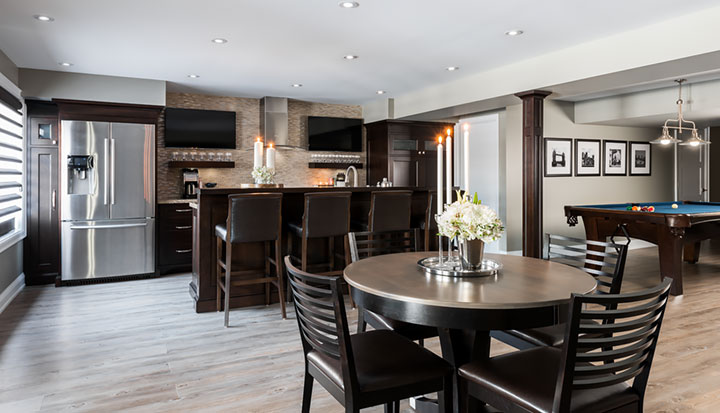
Solid and engineered hardwood continues to be the material of choice for many residential homes in North America. It is time to talk about colour and examples that illustrate these hue directions.
This is not a commentary on wood performance or brand, simply a designer’s view on what we recommend colour-wise to our clients.
There are 10 types of hardwood flooring, but if wood won’t work in certain applications, be sure to look at the porcelain “wood” tiles. They are amazing! Again, it always comes down to a matter of choosing the right colour! Check out Cercan Tile for great wood-looking porcelain tiles.
Dark hardwood
Dark-coloured hardwoods have been trending for the last 5 to 7 years and for some people, it will remain a staple colour. I like Vintage’s Gotham or Mercier’s Chocolate Brown as good options for dark hardwood colour choices. The vintage product is a solid material with a lightly hand-scraped surface. This finish helps to deflect light and will hide scratches and small nicks far better than smooth and shiny dark wood floors. If you want dark wood with low maintenance, this is the way to go.
Wire-brushed dark woods
This style of the floor is completely matte and textured, but with no undulations on the surface. This is a style that works well on a wide board with a modern feel. Make sure there is still a clear coating on the wood or you may find small flecks of dust will settle in the grain and ‘stick’. The clear coat helps to make cleaning easier.
Bottom line: dark wood colours are more formal as they add contrast to a room. They can add energy as well. They will require more cleaning if you live in the city (urban dust!) or if you have pets. Plus, they will show scratches and marks more than lighter colours, which are a less casual look.
Light wood floors
This category of colour has suffered much disdain after the 1980s, but we are seeing the return to lighter wood floors. Avoid light maples with certain clear coats, as they will turn yellow. Unfortunately, lighter woods do darken slightly over time, as this is the nature of wood. That being said, grayer-blonde woods have increased in popularity. Look for Vintage’s Orion or Kentwood’s Halfmoon Bay as cooler light wood options without the yellow undertone.
White/off-white floors
On the cutting edge of design today, light/almost white hardwood has witnessed a resurgence. It’s not for everyone, but it looks good for a farmhouse, vintage style or a mix of modern and traditional elements together. An example of this is Vintage’s hand-scraped Pearl or Kährs’ Oak Limestone. This is a painted rustic finish that will look more weathered over time (so keep this in mind if you want the floor to remain pristine!)
Bottom line: light wood floors are more casual and easier to care for as they tend to hide marks, fluff and dust better than darker colours. They add little contrast to light spaces and can reflect light to brighten a room. But, if you have a lot of dirt tracked in from outdoors, forget the white floor and go for blonde instead.
Medium coloured hardwoods
This range of colours includes cognacs, gunstock, medium brown, or antique brown; basically anything in the colour of lightly steeped tea.
This range of wood colours has a lot of variety and is less susceptible to trends as it’s in the middle range of contrast (neither really light nor really dark). I like Torlys’ Langford Smoked Oak. This wood colour is not too ‘orange’ which many people dislike as they drift to cooler beiges and grays in home furnishings. Also, have a look at Kentwood’s Brushed Oak Nutmeg or Satin Finish’s ‘Bourbon’.
Bottom line: medium wood floor colours offer some contrast to a room without dominating the space. They aren’t as dramatic as a white or espresso floor, so other items in the room will need to be stronger to give the room punch. This is a safe choice if you have a lot of activity in your house (and on your floors) or you don’t want anything too trendy.
Gray wood floors
Much has been made about the progression of gray as an option in hardwood flooring colours. There are some good choices like Vintage’s ‘Fumed White Oak’. That being said, the bigger trend here is the influence gray has had on the shade of brown and especially lighter, blonder colours. Brown and blonde hardwood have less orange in it today overall and this is evident in choices like Kentwood’s Glace Bay or Gray’s Harbor, both excellent gray options.
Bottom line: gray floors are a newer look and can be less intense than blonde or espresso. This colour is trendier and could wane in popularity over time, so pick it if you love it and don’t care what designers (like me!) have to say!

 White Oak Gotham
White Oak Gotham Hard Maple Chocolate Brown
Hard Maple Chocolate Brown White Oak Orion
White Oak Orion Sculpted Oak Halfmoon Bay
Sculpted Oak Halfmoon Bay Oak Limestone
Oak Limestone Langford Smoked Oak
Langford Smoked Oak Brushed Oak Nutmeg
Brushed Oak Nutmeg Brushed Oak Glace Bay
Brushed Oak Glace Bay Brushed Oak Gray’s Harbor
Brushed Oak Gray’s Harbor